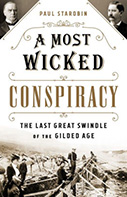A Most Wicked Conspiracy: The Last Great Swindle Of The Gilded Age

Author: Paul Starobin
Publisher: New York: Public Affairs, 2020. 320p.
Reviewer: Ian C. Hartman | February 2021
The history of the 1900 Nome Gold Rush has garnered attention from popular audiences and scholars alike. Novels, dissertations, and movies have all relayed the sordid tales of Alaska’s turn-of-the-century mining boom. Television programs depict the modern-day argonauts who have made their way north in search of gold and fast fortune. However, Paul Starobin’s account of a little known “great swindle” that shook the Nome gold fields and briefly landed its mastermind in prison is certainly among the most comprehensive and entertaining explorations of Nome in its heyday to date.
The narrative is centered around the prominent North Dakota political boss and Republican committeeman, Alexander McKenzie. The wicked conspiracy was McKenzie’s scheme to fix the nascent federal courts in Alaska, as it was then barely a generation under United States control, and to seize control of the gold fields. According to Starobin, McKenzie’s plan “was to make good on the sketchy mining claims held by the company [the Alaska Mining Company] by exploiting the investing public’s lust for gold” (59).
Indeed, in a complicated and rather contorted plan, McKenzie launched his Alaska Gold Mining Company, effectively a shell company through which to launder money and fleece investors. He then lobbied, or, more accurately, bribed, senators to confirm a complicit judge who would in turn rule to strip foreign-born miners of their lucrative claims. McKenzie also secured friendly rulings from the bench that greenlighted the Alaska Mining Company’s claim to Nome’s gold dust-flecked beaches. As faraway investors took note and the company’s value stood poised to skyrocket, McKenzie and his associates planned to cash out before a higher court or congress figured out the ploy and eventually halted the operation. McKenzie and his associates expected to get rich without ever working a sluice box or swirling a gold pan.
Like any good heist, it appeared for a short time that McKenzie and his associates might even have gotten away with it. However, dogged journalists and a few honest politicians and judges (apparently that was not a contradiction in terms even at the height of the Gilded Age) caught on to McKenzie’s game. By the end of the year, the Ninth Circuit Court of Appeals in San Francisco called on McKenzie to answer for his apparent misdeeds and unlawful behavior. A particularly earnest group of judges and attorneys called San Francisco home by century’s end. Having close knowledge of the California gold rush, they were keenly attuned to the excesses of mining booms and busts, and they took particular interest in the events up north.
After McKenzie defied the Ninth Circuit, U.S. marshals arrived in Nome to arrest him. The marshals took McKenzie to California, where he faced trial and was soon convicted and sent to prison on the charge of contempt of court. On the eve of his sentence, the Alaska Mining Company reached what may have been its peak value of roughly $15 million (217). Yet, McKenzie’s political connections ran straight to the White House and President William McKinley. Just months before he was assassinated, McKinley issued a pardon to McKenzie, relieving him of a prison term for which he had served three months of a one-year sentence.
A Most Wicked Conspiracy is a narrative rooted in Starobin’s impressive research, attention to detail, and impressively clear prose. He uses the McKenzie’s archival papers, the newspapers in and around Nome, and various other federal records to map McKenzie’s plan one sordid step after the next. The book has a dizzying array of characters that sometimes muddies the story, but Starobin is a talented writer who keeps the narrative moving at a brisk pace. The author has written a work of nonfiction history that often reads as a legal drama with a series of twists and turns, even as the outcome is never quite in doubt. While historians of the Gilded Age may find the book particularly illuminating, the target audience is not scholarly, and anyone who appreciates a good heist and scandal will find this book engaging. The latter chapters do a particularly admirable job in describing the legal process by which McKenzie’s scheme unravels.
Readers will find McKenzie’s manipulation of the senate and the judiciary galling but not entirely surprising given the Gilded Age’s association with political malfeasance and cronyism. Starobin nonetheless proposes that the scandal stands out in an era known for its corruption and greed. After all, the highest profile examples of Gilded Age corruption exposed graft and wrongdoing in either one branch of government or another. The Credit Mobilier scandal, for instance, was largely confined to the legislature. Writing huge railroad subsidies into law and personally benefiting from that same industry, congressmen shamelessly bilked the federal government of millions in the early 1870s. The Grant administration dealt with executive-level scandals such as the notorious Whiskey Ring, led by crooked agents in the Internal Revenue Service. Few would dispute the questionable practices of the financial service industry throughout the Gilded Age and beyond. McKenzie’s scheme is striking in its attempt to shape the federal judiciary, buy senate votes, and launch an illegitimate corporate enterprise, all in one singular venture.
But not all of Starobin’s claims should be taken as literal truth. Notably the very subtitle of the book flatly proclaims that McKenzie’s transgression was the “last great swindle of the Gilded Age.” In fact, one might argue that it wasn’t even the last great swindle in Alaska during these years. That recognition could go to the infamous Alaska Syndicate, a business and development consortium led by J.P. Morgan and Simon Guggenheim. The Syndicate monopolized transportation into Alaska’s interior and spearheaded the development of the natural resources located along the Copper River basin. After laying claim to a stretch of land laden with rich copper seams, the Alaska Syndicate ran afoul of conservation-minded Alaskans and others skeptical of concentrated economic power.
The Alaska Syndicate came under scrutiny amid the trustbusting efforts of Presidents Theodore Roosevelt and William Howard Taft. Gifford Pinchot, the notable conservationist, led the charge. So too did the Alaska judge-turned-politician, James Wickersham (a man mentioned but not thoroughly detailed in Starobin’s book). While no one went to jail, brazenly fixed votes in the senate, or rigged the judiciary, the battle over whether or not to subject Alaska’s vast and unspoiled wilderness to resource extraction facilitated a split in the Republican Party between advocates of unimpeded big business and those who favored trust busting and conservation. It also revealed in plain sight that which was perfectly legal in an era of light to nonexistent regulation of the environment and American capitalism. The Syndicate continued to operate in Alaska and exert influence, albeit in a more limited capacity focused primarily in the copper mining districts, through the 1930s. However, the Great Depression led to a collapse in the price of copper and of a mining industry in Alaska that never fully recovered.
The case of Alex McKenzie and the battle over the Alaska Syndicate thus highlight the surprising role that Alaska played in the rough and tumble politics of turn-of-the-century America. Far from a “last frontier,” as its long been known, Alaska might better be viewed as at once deeply illustrative of the nation’s graft and crony capitalism that defined the Gilded Age, but also a laboratory for the Progressivism that followed it. Judge James Wickersham, the conscientious counterpoint to Judge Arthur Noyes, the man who issued the favorable rulings that allowed McKenzie to seize Nome’s most lucrative mining claims, highlights the point. Wickersham cleaned up the district after the disgraced Noyes, reimposed the rule of law, and then launched a political career that vaulted him to the top of Alaska’s politics for a generation. Wickersham served as Alaska’s delegate in congress for over twenty years; he led the movement for Alaska to gain territorial status and for the construction of the Alaska Railroad, the nation’s only federally owned and operated railroad (the federal government eventually transferred ownership to the State of Alaska in 1983).
Indeed, if McKenzie and Noyes represented the excesses of the Gilded Age, Wickersham represented the spirit of the Progressive Era, reform-minded and dedicated to the principles of good government. In both instances, Alaska reflected national trends, and its notable figures embodied the changing views on what role the government should play in regulating business and the environment. In addition, as a western territory dependent on the presence of federal officials to administer justice and regulate the economy, Alaska at the turn of the century demonstrated the limits of a national government based over four thousand miles away in Washington D.C.
Today, a common pastime among many Alaskans is to grouse over the perception of government intrusion and decry an expansive federal bureaucracy that doesn’t always serve the state’s interests. Meanwhile, salacious schemes like those hatched by Alex McKenzie may be rare, but Alaska remains a place where businesses and individuals have long come to get rich quick and get out; concern for the well-being of the state and its people is often secondary at best. Thus, while lamentations of federal overreach will always be in season among the state’s political class, the curious case of Alexander McKenzie should serve as a reminder to residents of the forty-ninth state that the alternative is far less desirable.
Ian C. Hartman is associate professor and chair of the Department of History at the University of Alaska Anchorage


